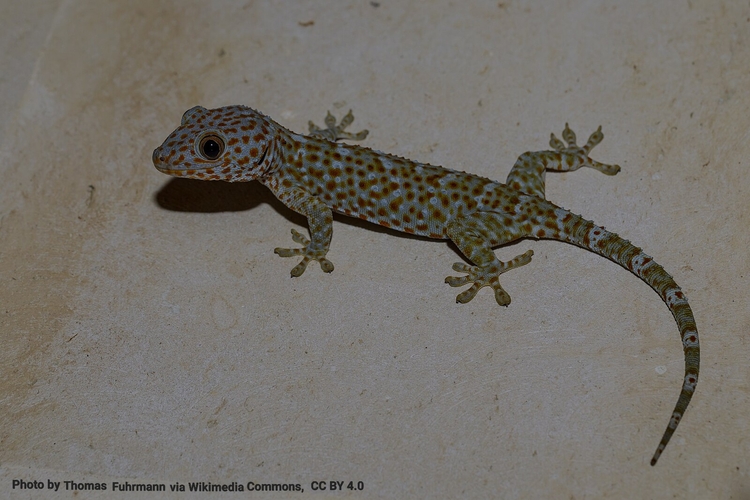The Gecko’s Nanoscale Feet: Defying Both Gravity and Evolution
Picture this: a gecko scurries effortlessly across your ceiling, pauses upside down on a pane of glass, then darts up a perfectly smooth wall without missing a step. If you scaled this feat to human proportions, you’d need adhesive hands the size of large pizzas to support your 150-pound frame. Yet this small reptile accomplishes the impossible with feet no bigger than your thumbnail, leaving no residue, making no sound, and ready to repeat the performance thousands of times without losing effectiveness.
THE GECKO’S FEET: A SCIENTIFIC MARVEL
To understand why gecko adhesion defies evolutionary explanation, we must first grasp the staggering complexity of what appears to be a simple biological function. The gecko’s foot operates as a masterpiece of multi-level engineering that puts our most advanced nanotechnology to shame.
- The Numbers Game: Each gecko foot contains approximately 2 million hair-like structures called setae, with each seta branching into roughly 1,000 even tinier spatulae. This creates an astounding 2 billion points of molecular contact per foot—more connection points than there are stars in the Andromeda Galaxy. The gecko can literally hang from the ceiling by a single toe, supporting twenty times its body weight through molecular forces alone.
- Physics in Motion: These spatulae exploit van der Waals forces, the weak but measurable attraction that exists between all molecules when they come extremely close together. While individually each molecular bond is weaker than a spider’s silk, collectively they generate enough adhesive force to create what researchers call “dry adhesion.” This requires the spatulae to make contact at distances measured in nanometres—a precision that challenges our most sophisticated manufacturing techniques.
- Geometric Perfection: The entire system operates through precise geometric relationships that must be maintained across millions of contact points. Each spatula must be angled at exactly 30 degrees to achieve optimal molecular contact with any surface. Even minor deviations from this angle result in dramatic loss of adhesive capability.
- Material Science Mastery: The beta-keratin composition of gecko setae possesses exactly the right flexibility for the system to function. Too stiff and the spatulae can’t conform to microscopic surface irregularities; too flexible and they can’t maintain the necessary contact pressure. This material represents a unique biological polymer found nowhere else in the animal kingdom, engineered specifically for this application.
- Built-in Maintenance System: Perhaps most remarkably, the system includes a self-cleaning mechanism that operates automatically. As the gecko lifts its foot, the precisely angled spatulae shed dust and debris that would otherwise contaminate the surface and destroy molecular adhesion.
THE EVOLUTIONARY IMPOSSIBILITY
The complexity revealed in gecko adhesion creates insurmountable problems for evolutionary theory. Unlike other biological features that might provide some benefit even when partially developed, gecko feet present “irreducible complexity”—systems that cease to function if any component is removed or underdeveloped.
The All-or-Nothing Problem: A gecko with half-developed setae gains no survival advantage over a gecko with no adhesive capability—it simply falls off walls from greater heights. The system requires complete integration of all hierarchical levels to provide any benefit whatsoever. Partial gecko feet don’t make climbing “somewhat easier”—they make it impossible, eliminating any selective pressure that could drive gradual development.
Multiple Simultaneous Requirements: For gecko adhesion to work, numerous independent factors must align perfectly and simultaneously. The hierarchical structure requires four distinct levels of organisation (toe-lamella-setae-spatulae), each precisely engineered. The material composition demands exact beta-keratin properties that differ from all other biological keratins. The geometric relationships require nanometre-level precision maintained across millions of structures, with neural pathways coordinating split-second attachment and detachment.
Statistical Impossibility: The probability of random mutations producing even the basic molecular geometry has been calculated at less than 1 in 10^77—a number that exceeds the estimated atoms in the observable universe. This calculation doesn’t even account for the integrated systems that must work together, the specific material properties required, or the neural control mechanisms. The mathematical odds against gecko adhesion arising through undirected processes effectively equal zero.
Missing Transitional Evidence: Despite extensive fossil searches, palaeontologists have found no transitional forms showing gradual development of gecko-style adhesion. Gecko feet appear in the fossil record fully formed and fully functional, exactly as we observe them today. The absence of intermediate stages in both living species and fossil evidence points to sudden appearance rather than gradual assembly.
BIOMIMICRY: HUMAN ENGINEERS TAKE NOTICE
The design excellence of the gecko’s nanoscale feet hasn’t escaped the attention of human engineers. The field of biomimetics—copying nature’s designs for technological applications—has invested millions of dollars attempting to replicate gecko adhesion. Researchers have developed gecko-inspired medical bandages, wall-climbing robots, and even adhesives for space applications.
Yet despite teams of PhD engineers armed with electron microscopes and million-dollar fabrication equipment, our best attempts remain crude approximations of the natural system. We can create synthetic setae, but not with the precision spacing. We can generate van der Waals adhesion, but not with the gecko’s efficiency. We can build self-cleaning surfaces, but not with the elegance of the gecko’s automatic maintenance system.
This raises a profound question: if it requires intelligent human engineers to even approximate gecko performance, what does this suggest about the origin of the vastly superior original system?
The biomimetics field itself testifies to the reality of biological design. These researchers don’t study random mutations—they study engineering solutions. They don’t look for evolutionary accidents—they seek design principles to copy. Their very methodology acknowledges what they observe: systems that display the unmistakable hallmarks of purposeful engineering.
ALTERNATIVE EXPLANATIONS EXAMINED
Proponents of evolutionary theory typically offer two explanations for gecko adhesion: gradual development through natural selection, or convergent evolution where similar solutions arise independently.
- The gradual evolution argument falls apart under scrutiny because partial gecko feet provide no selective advantage. A gecko that can only stick to walls 50% of the time doesn’t survive longer than one that can’t stick at all—it simply falls from greater heights.
- The convergent evolution argument fares no better. Other climbing creatures use entirely different solutions: cats have retractable claws, tree frogs use suction cups, and spiders employ different types of microscopic hairs. The gecko’s use of van der Waals forces through precisely angled spatulae represents a unique solution found nowhere else in nature.
- The Exaptation Hypothesis: A more sophisticated evolutionary argument suggests setae originally evolved for a different purpose and were later “co-opted” for adhesion. However, this explanation merely pushes the complexity problem back one step without solving it—it still cannot account for how structures with the exact geometric precision, material properties, and hierarchical organisation necessary for van der Waals adhesion could arise for any other purpose.
THE GECKO’S FEET: THE FINGERPRINT OF INTELLIGENCE
When we step back and examine the evidence objectively, gecko feet display every characteristic we’ve come to associate with intelligent design. They exhibit irreducible complexity, where all parts must be present and precisely coordinated for the system to function. They demonstrate specified complexity, with exact geometric and material requirements that serve a clear purpose. They show anticipatory design, with built-in maintenance systems and fail-safes.
As we continue to probe deeper into the natural world, from the quantum mechanics of photosynthesis to the information processing systems of DNA, we find not the simple building blocks that early evolutionists expected, but layer upon layer of sophisticated engineering. The gecko’s impossible grip on smooth surfaces serves as a perfect microcosm of this larger reality: sometimes the most reasonable explanation for extraordinary design is an extraordinary Designer.
In the end, the gecko doesn’t just defy gravity—it defies us to ignore the evidence of purposeful intelligence written in every nanoscale detail of its remarkable feet.
THE GECKO’S FEET: RELATED FAQs
Do all gecko species have the same adhesive capabilities? Not all geckos possess the same level of adhesive power, which creates additional challenges for evolutionary explanations. While most gecko species can climb smooth surfaces, some desert-dwelling geckos have reduced adhesive abilities, and a few species have lost wall-climbing capability entirely. From a creationist perspective, this variation suggests purposeful design matching each species to its intended habitat rather than random evolutionary loss of a beneficial trait.
- How do geckos control when to stick and when to release from surfaces? Geckos achieve instant attachment and detachment through precise muscle control that changes the angle of their setae. When the spatulae contact a surface at the optimal 30-degree angle, van der Waals forces activate; when muscles curl the toes to change this angle, the gecko releases immediately. This split-second neural coordination of millions of microscopic structures represents a control system of staggering sophistication.
- What happens to gecko feet as they age—do they wear out? Remarkably, gecko adhesive performance remains consistent throughout their lives due to a continuous replacement system for worn setae. Old setae are shed and replaced on a regular cycle, maintaining optimal adhesive capability across the gecko’s entire lifespan. This built-in maintenance and replacement protocol demonstrates anticipatory design – the original system included provisions for long-term functionality. Such foresight in biological engineering points to intelligent planning rather than undirected evolutionary processes.
Can gecko adhesion work in space or underwater? Gecko adhesion functions in vacuum conditions, making it highly valuable for space applications, but fails underwater because water molecules interfere with van der Waals forces. The selective functionality reveals the precise physics underlying the system – it works exactly where molecular adhesion is possible and fails where it isn’t. From a design perspective, this represents engineering that operates within the fundamental laws of physics rather than violating them, suggesting a Designer who works through natural law rather than against it.
- Why don’t gecko feet stick to non-stick surfaces like Teflon? Gecko feet cannot adhere to surfaces with extremely low surface energy, such as Teflon, because these materials provide insufficient molecular interaction for van der Waals forces to operate effectively. However, geckos can still climb most “non-stick” surfaces that challenge human adhesives, including wet glass and dusty walls. This limitation actually supports the design argument—the system works precisely as physics would predict for van der Waals adhesion, operating within natural law rather than through mysterious biological magic.
- Do geckos leave any trace or residue when climbing? Unlike human-made adhesives, gecko feet leave absolutely no residue and cause no surface damage, even after millions of attachment cycles. The van der Waals forces operate through molecular attraction rather than chemical bonding, allowing complete reversibility without material transfer. This “perfect adhesion” that leaves surfaces exactly as found represents an engineering ideal that human technology still struggles to achieve.
How do baby geckos develop their adhesive abilities? Newly hatched geckos possess fully functional adhesive systems from birth, with all hierarchical structures (setae, spatulae, and precise angles) perfectly formed and ready for immediate use. There is no gradual development period where young geckos “learn” to climb—the entire system operates at full efficiency from day one.
THE GECKO’S FEET: OUR RELATED POSTS
- The Emperor Penguin: Designed to Thrive in Extreme Climates
- The Pelican: Precision-Engineered Fishing Vessel
- Explosive Evidence: How the Bombardier Beetle Demolishes Darwinism
- Nature’s Puzzle: The Platypus as Evidence of Divine Engineering
- Bats: How Nature’s Flying Marvels Defy Evolution
- Tadpole to Frog: How Metamorphosis Reveals Divine Programming
- Honeybees: 5 Ways Nature’s Unsung Architects Point to the Creator
- Testament to Design: The Engineering Marvel of Elephants
- Blue Whales: Mammoth Icons of Intelligent Design
- The Woodpecker’s Design: How Nature’s Headbanger Defies Evolution
- Too Perfect to Be Random: The Giraffe’s Remarkable Design
Editor’s Pick

Sacred Fury: What Christ’s Temple Cleansing Truly Means
Mark 11 records the crack of a handmade whip that echoed through the temple corridors. Tables crashed to the ground, [...]

Did Jesus Cleanse the Temple Twice?
OR DID JOHN DISAGREE WITH THE SYNOPTICS ON TIMING? One of sceptics’ favourite "gotcha" questions targets what they see as [...]

Self-Authentication: Why Scripture Doesn’t Need External Validation
"How can the Bible prove itself? Isn't that circular reasoning?" This objection echoes through university classrooms, coffee shop discussions, and [...]

The Racial Diversity Question: Does the Bible Have Answers?
Walk into any bustling metropolis today and you'll likely witness humanity's breathtaking diversity—the deep ebony skin of a Sudanese family, [...]

Do Christians Need Holy Shrines? Why the Reformed Answer Is No
Walk into a medieval cathedral and you'll encounter ornate shrines, gilded reliquaries, and designated "holy places" where pilgrims gather to [...]

If God Is Sovereign, Why Bother Praying?
DOESN’T DIVINE SOVEREIGNTY OBVIATE PRAYER? **Editor’s Note: This post is part of our series, ‘Satan’s Lies: Common Deceptions in the [...]

I Want To Believe, But Can’t: What Do I Do?
"I want to believe in God. I really do. But I just can't seem to make it happen. I've tried [...]

BC 1446 or 1250: When Did the Exodus Really Happen?
WHY REFORMED SCHOLARS SUPPORT THE EARLY DATE Many a critic makes the claim: “Archaeology has disproven the biblical account [...]

Does God Know the Future? All of It, Perfectly?
Think about this: our prayers tell on us. Every time we ask God for something, we’re confessing—often without realising it—what [...]

Can Christian Couples Choose Permanent Birth Control?
Consider Sarah, whose fourth pregnancy nearly killed her due to severe pre-eclampsia, leaving her hospitalised for months. Or David and [...]





